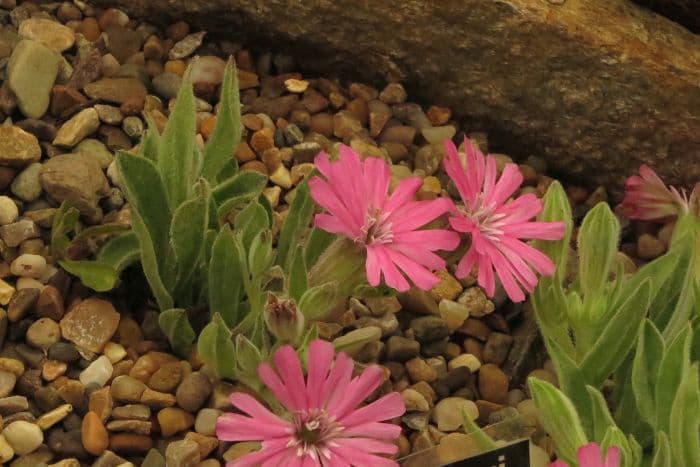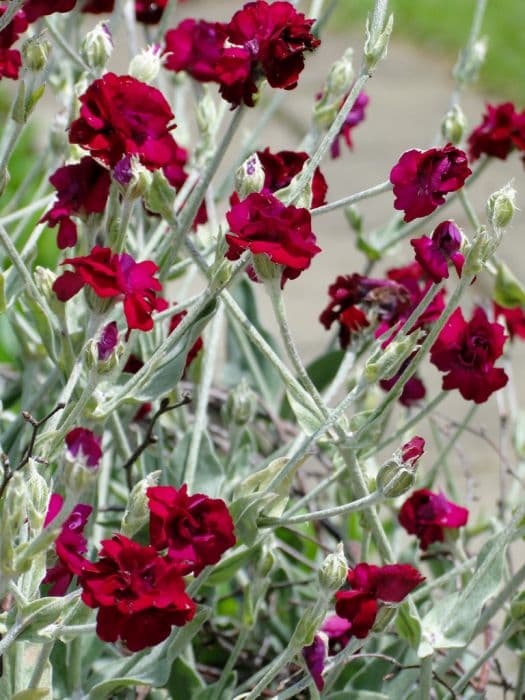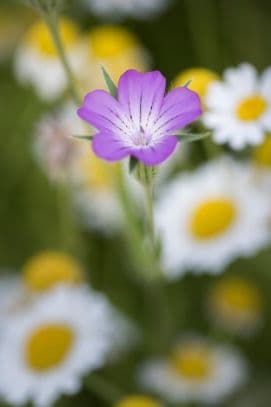Hooker's Indian Pink Silene hookeri Ingramii Group

ABOUT
Silene hookeri, commonly referred to as Hooker's Silene or Catchfly, is a plant that is known for its striking appearance. This plant typically boasts lush, green foliage consisting of oval to lance-shaped leaves that may vary in texture and provide a verdant backdrop to the colorful flowers. The Ingramii Group cultivates within this species are celebrated for their ornamental blooms, which emerge on slender stalks and command attention in a garden setting. The flowers of the Ingramii Group typically possess a vibrant palette ranging from deep magenta to bright pink hues. Each blossom is composed of a tubular calyx that transitions into broader, petal-like lobes, emanating a romantic and delicate impression. The petals may display a distinct notch at their tip, adding to the dynamic form of the inflorescence. Additionally, these petals often showcase intricate venation or subtle variations in color intensity, further accentuating their allure. At the center of the flower, reproductive structures like stamens and pistils can sometimes be visible, providing a contrasting point of interest and contributing to the plant's reproductive process. The blooms generally exude a gentle fragrance that attracts pollinators and adds to the sensory experience of the onlooker. As the flowering season progresses, the Ingramii Group may develop capsule-like fruit that contains numerous seeds, ensuring the propagation and longevity of this enchanting species in its native or cultivated habitat. Overall, Silene hookeri of the Ingramii Group bears an aesthetic charm with its bright and alluring flowers set against its verdant leaves, making it a prized choice for gardeners seeking to infuse their landscapes with color and life.
About this plant
 Names
NamesFamily
Caryophyllaceae
Synonyms
Hooker's Silene, Blue Mountain Catchfly, Ingram's Catchfly
Common names
Silene hookeri ssp. ingramii, Silene ingramii.
 Toxicity
ToxicityTo humans
The Silene hookeri, commonly known as Hooker's Silene, is not widely known for being toxic to humans. However, while there is limited information on the specific Ingramii Group, plants in the Silene genus are generally not considered highly toxic. If ingested, they might cause mild to no symptoms, typically not leading to serious health consequences. As with any plant, individual sensitivities can vary, and it's always best to avoid eating plants not specifically intended for consumption to prevent any potential adverse reactions.
To pets
Hooker's Silene is not commonly reported to be toxic to pets. However, as with humans, the specific Ingramii Group's effects on pets are not well-documented. Members of the Silene genus typically do not pose serious risks, but mild gastrointestinal upset is a potential consequence if pets consume parts of these plants. Since each pet may react differently to various plants, it is advisable to prevent pets from ingesting plants not meant for their consumption.
 Characteristics
CharacteristicsLife cycle
Perennials
Foliage type
Evergreen
Color of leaves
Green
Flower color
Pink
Height
1 foot (30 cm)
Spread
1 foot (30 cm)
Plant type
Herb
Hardiness zones
8
Native area
North America
Benefits
 General Benefits
General Benefits- Attracts Pollinators: Silene hookeri, commonly known as catchfly, invites beneficial insects like bees and butterflies, supporting local ecosystems.
- Drought Tolerance: Once established, catchfly is resistant to periods of low water availability, making it suitable for xeriscaping.
- Erosion Control: The plant's root system helps to stabilize soil and prevent the erosion of slopes or banks.
- Low Maintenance: Catchfly generally requires minimal upkeep, making it a practical choice for gardeners seeking low-maintenance plants.
- Ornamental Appeal: With its vibrant flowers, catchfly adds color and visual interest to gardens and landscapes.
- Wildlife Habitat: Catchfly provides a habitat and food source for various wildlife species, including caterpillars of some butterflies and moths.
- Adaptability: It can adapt to a variety of soil types, although it prefers well-draining soil, broadening its potential planting locations.
 Medical Properties
Medical PropertiesThis plant is not used for medical purposes.
 Air-purifying Qualities
Air-purifying QualitiesThis plant is not specifically known for air purifying qualities.
 Other Uses
Other Uses- Silene hookeri, also known as Hooker's Indian Pink, can be used in thematic gardens such as fairy gardens due to its whimsical appearance and vibrant flowers.
- The plant serves as an educational tool in ecology and botany programs, illustrating plant-pollinator relationships and adaptations.
- As an ornamental, Hooker's Indian Pink can be utilized in rock gardens because of its ability to grow in well-draining soil and add color contrast.
- The plant can be incorporated into moon gardens, as its flowers may remain open at dusk, attracting nocturnal pollinators.
- Hooker's Indian Pink is suitable for butterfly gardens as it attracts butterflies and other beneficial insects.
- In floral arrangements, the vibrant flowers of Silene hookeri can provide a delicate addition to both fresh and dried bouquets.
- This plant can be used in garden border design for its low height, serving as a colorful edge to pathways and flower beds.
- Hooker's Indian Pink can be a living mulch, as its foliage can cover bare soil and help retain moisture while suppressing weeds.
- Photographers might use the plant as a subject for macro photography, capturing its intricate patterns and vivid colors.
- In xeriscape landscaping, Silene hookeri is an appropriate choice due to its ability to thrive in dry conditions once established.
Interesting Facts
 Feng Shui
Feng ShuiThe Catchfly is not used in Feng Shui practice.
 Zodiac Sign Compitability
Zodiac Sign CompitabilityThe Catchfly is not used in astrology practice.
 Plant Symbolism
Plant Symbolism- No widely recognized symbolism: Silene hookeri, commonly known as Hooker's Indian pink, does not have a widely recognized set of symbolic meanings in the same way that other, more culturally significant plants like roses or lilies do.
- Potential personal symbolism: While not culturally established, individuals or specific cultures may assign their own symbolism to Hooker's Indian pink, potentially related to its habitat, appearance, or personal experiences with the plant.
 Water
WaterThe catchfly, also known as Silene hookeri 'Ingramii Group', prefers moderate watering. Establish a regular watering routine such as once a week, but adjust according to the seasons and local weather conditions. For established plants, water with approximately one gallon of water, ensuring the soil is thoroughly moistened but not waterlogged. During hot summer months, the catchfly may need more frequent watering; monitor the soil moisture and increase the frequency if the top inch of soil feels dry to the touch. In contrast, reduce watering during the winter when the plant's growth slows down, and ensure proper drainage to prevent root rot.
 Light
LightCatchfly thrives in full sun to partial shade conditions. It is best placed in a location where it will receive a minimum of six hours of direct sunlight daily, though it can tolerate some light afternoon shade. Avoid deeply shaded spots, as too little light can inhibit flowering and lead to leggy growth.
 Temperature
TemperatureCatchfly is hardy and can manage in a range of temperatures. Ideally, it should be kept in conditions between 50°F and 75°F for optimal growth. However, it can survive occasional dips down to 30°F or rises up to 90°F. Avoid exposing the plant to extreme temperatures outside this range for extended periods to prevent stress and damage.
 Pruning
PruningPruning catchfly can help maintain its shape and encourage denser growth. Prune in the late winter or early spring before new growth starts. Deadheading, or removing spent flowers, will promote further blooming throughout the season. Cut back the stems by approximately one third after the main flowering period to refresh the plant and potentially encourage a second bloom.
 Cleaning
CleaningAs needed
 Soil
SoilSilene hookeri, also known as Hooker's Indian Pink, thrives in well-draining soil with a slightly acidic to neutral pH, typically ranging from 6.0 to 7.0. The ideal soil mix should consist of garden soil, compost, and sand or perlite to improve drainage.
 Repotting
RepottingHooker's Indian Pink, should be repotted every 2-3 years or when it becomes root-bound. Regular repotting helps refresh the soil and provide room for growth.
 Humidity & Misting
Humidity & MistingHooker's Indian Pink prefers moderate to low humidity levels, as it is accustomed to well-ventilated environments.
 Suitable locations
Suitable locationsIndoor
Place in bright, indirect light and ensure good air flow.
Outdoor
Needs full sun to partial shade, in well-drained soil.
Hardiness zone
4-8 USDA
 Life cycle
Life cycleSilene hookeri, commonly known as Hooker's Silene or Catchfly, starts its life cycle as a seed that germinates in late winter to early spring, depending on the climate. The seedling establishes a root system and develops a basal rosette of leaves. As the plant matures, it begins vegetative growth with stems branching out from the base. Flowering typically occurs in late spring to early summer, with flowers being pollinated by insects, leading to seed formation. Seeds are dispersed later in the season, and the plant may die back in the winter, especially if it's an annual or biennial. In regions with milder climates or if the plant is perennial, it may overwinter with foliage remaining evergreen or semi-evergreen, to begin the cycle anew with the return of favorable growing conditions.
 Propogation
PropogationPropogation time
Spring-Early Summer
The most popular method of propagation for Silene hookeri, commonly known as Catchfly or Hooker's Indian Pink, is by seed. The best time for sowing seeds of Catchfly is in spring, after the threat of frost has passed, to allow for a full growing season. To propagate, seeds should be scattered on the surface of a well-draining soil mix and lightly pressed into the soil. They require light to germinate, so they shouldn't be covered with soil. Keep the soil consistently moist but not waterlogged. Germination usually takes place within 2 to 4 weeks at temperatures around 68-72 degrees Fahrenheit (20-22 degrees Celsius). Seedlings can then be transplanted to their final location once they are large enough to handle and have developed a couple of true leaves.






![Pink [Cherry Daiquiri]](/_next/image?url=https%3A%2F%2Fplants-admin.emdemapps.com%2Fimages%2Fplants%2F%2Fimages%2F604b53704a83a.png&w=640&q=75)

![Pink [Passion]](/_next/image?url=https%3A%2F%2Fplants-admin.emdemapps.com%2Fimages%2Fplants%2F%2Fimages%2F604b53b9b9334.png&w=640&q=75)